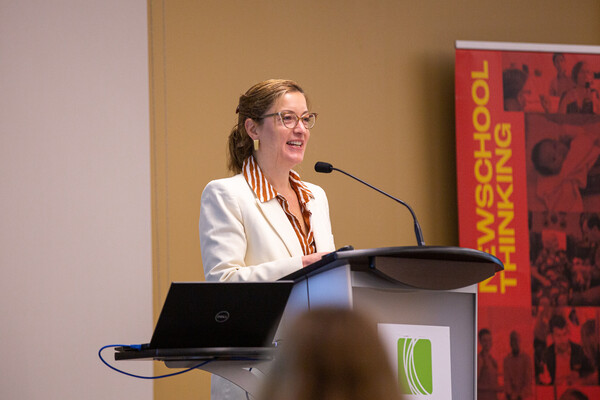Chair's message: The primacy of primary care

Spring is in full bloom and as the academic year winds down, there is much to celebrate (senior promotions!) and look forward to (graduation and an end-of-year BBQ)! Read our senior promotions announcement to learn more about the faculty members promoted this year and their work. I am looking forward to seeing more of you in person. Please mark the evening of June 20th on your calendars for our Celebration of Family Medicine BBQ—stay tuned for more details.
If you didn’t catch it, I’m including below a piece I wrote for the Temerty Faculty of Medicine on the primary care crisis in Canada, and solutions our department is putting forward to fix it.
Sincerely,
Danielle
The Primacy of Primary Care
“Can you help me find a family doctor?”
As Chair of the Department of Family and Community Medicine (DFCM) at the University of Toronto, I am asked this question nearly every day. All around us, people have lost access to the entranceway to our health system – and are wondering what to do about it.
If it feels like primary care in Canada is in crisis, that’s because it is. Over 6.5 million Canadian residents are without a family doctor or nurse practitioner. In Ontario, more than 2.2 million people were without a regular physician as of March 2022, which is a 24 per cent increase compared with March 2020, when the COVID-19 pandemic began to impact our province. Even for those who have a relationship, access can be challenging despite the hard work of the people and teams in the system. Canada consistently ranks poorly on international rankings of timely access to primary care.
When primary care doesn’t meet community needs, nothing else in the health system can work effectively. Family physicians are the first point of contact for almost all interactions with the health system. While approximately 3,000 people are admitted daily to hospitals in Ontario, over 160,000 visits occur with a general practitioner. Systems built on strong primary care produce better health outcomes, more equitably, and at lower costs. In the words of Dr. Tedros Adhanom Ghebreyesus, the Director General of the World Health Organization, “primary health care is where the battle for human health is won and lost.”
The reasons behind the crisis are complex. Many come down to human resources. Early in the pandemic, we saw a doubling of family doctors stopping work in Ontario, and 1.7 million Ontarians are attached to a family doctor aged 65 or older. There is also a trend among family doctors of all ages and stages to work in a more focused practice: whether in hospital wards, emergency departments, palliative care, or mental health care. These are critical services for communities, but it means that many of our family physicians are not taking on – or keeping – office-based practices.
The practice of family medicine itself is also incredibly challenging in the current environment. As the population ages, care needs become more complex, and the administrative burden associated with the job rises. Family doctors face administrative tasks that can take up to 19 hours a week, leaving less time for clinical care. When wait times for specialty care, advanced imaging, and procedures are long, more work falls on the primary care clinician or team to help patients manage their situation while they wait.
The upshot is that family doctors are working harder and feeling burned out. Yet, patients are having a terrible time finding a family doctor or getting in to see their doctor.
Our trainees see and feel this pressure. You will have heard in recent weeks about the challenge of attracting MD students to train and work in family medicine. While U of T has filled all but two postgraduate training spots in family medicine after the initial round of the CaRMS Match, many family medicine training positions still need to be filled nationwide.
So, what can we do about all this? Many of the solutions are straightforward and within reach – but that does not mean they are easy to implement! Some will cost money, while some will take time. Others will require a cultural shift in how the health system works and clinicians practice. Thought leadership on all these fronts is needed from DFCM at Temerty Medicine, the world's largest academic department of family and community medicine. Our DFCM strategic plan outlines some ways we plan to contribute using the powerful tools of research, education, and quality improvement. It takes leadership, community, and relationships.
LEADERSHIP
Listen to patients:
Dr. Tara Kiran, the Vice Chair of Quality and Innovation at DFCM and Fidani Chair in Quality and Innovation, has conducted the largest study yet of Canadian residents, asking them what they want and expect from primary care. The OurCare initiative includes a national research survey of nearly 10,000 people and in-depth priorities panels in five provinces in which policy issues are being considered deeply by the system's users. Dr. Kiran has been heartened to find that patients want relationship-based care, noting they expect that the family doctor “knows their patients as people and considers all the factors that affect their health, that they stand up for their patients, and that they co-ordinate their patients’ care across multiple places. Almost 90 per cent also said it was important to them that their care was close to home.” By conducting research that engages people in Canada directly, we can help to shape the policy agenda.
COMMUNITY
Expand family medicine education in the communities that need it most:
The need to expand education in family medicine and primary care is evident. The Ontario government, which has recently increased the number of medical resident positions across the province, has designated 60 per cent of these new positions for family medicine trainees. Yet, we must reimagine how we prepare future family physicians to ensure that we train people in the communities where they are most needed. Our DFCM strategic plan commits to expanding and enhancing the community-based experience of learners through concrete actions such as:
- Increasing opportunities for medical learners to engage with community organizations and providers through clinical and non-clinical community-based opportunities; and,
- Embracing a community-serving mindset in the curriculum that pays special attention to health equity in considering population health outcomes and social & structural determinants of health, including training in patient and system advocacy.
The College of Family Physicians Canada plans to increase training for family medicine residents by one year in the coming decade. We hope this massive shift in our program will offer opportunities for our learners to be even better prepared to meet community needs.
RELATIONSHIPS
Embrace the team in all we do:
The practice of family medicine is at an inflection point. The notion of a single operator providing family medicine care alone with minimal administrative support doesn’t meet the needs of patients or physicians. It is evident that interprofessional care is better for patients and can extend the capacity of physicians and nurses, improving access for everyone. We need to adjust our model of care to respond to these developments. Yet, in Ontario, less than 30 per cent of the population has access to a team that includes professionals like nurses, social workers, and pharmacists—and areas with the greatest needs have the fewest team resources. DFCM has committed to further embedding learners in high-functioning teams and enhancing opportunities for interprofessional healthcare team members to participate fully in our work. We must also support advocacy to expand teams, starting with equity-deserving communities. Finally, we can rejuvenate our discipline by fixing some pain points in daily practice.
The secret sauce of primary care is relationships. Ours is a discipline based on longitudinal interactions. Over many years, we have the privilege of coming to know our patients, understanding their underlying conditions and social environments, and walking the path of illness and health alongside them. It is a tremendous privilege to do that work. But unfortunately, this ideal is too often frustrated for both clinicians and patients.
Temerty Medicine has the expertise, experience, and leadership to advocate for the required changes to our training and care delivery systems. This is why we have established the Office of Health System Partnership (OHSP) in DFCM so that we can capitalize on our strengths and become more engaged in health system leadership. Through OHSP, we are working with the Ontario Health Toronto Region to support its goal of connecting and coordinating our current health system and its many complex parts. We want to empower primary care, as the ‘front door’ of our health care system, to scaffold and coordinate the breadth of services that primary care provides to improve the health of our patients, ensure our communities are more resilient, and strengthen the system. Through OHSP and by working in collaboration with our fellow medical schools and health professionals, we can achieve the integrated care our patients need.
News



